Hypersensitive dentine




Hypersensitive dentine can be found in any tooth, but it is most frequent in upper canines and all premolars. It is almost always on the buccal side of the tooth. The reason for dentine hypersensitivity is supposedly exposed dentine at the cervical area of the tooth, which allows irritation of the odontoblast/nerve endings complex via rapid changes in the dentinal fluid flow in the tubules. It is important to diagnose hypersensitive dentine because it often does not require endodontic treatment. Primary treatment is protection of the dentine by occluding the dentinal tubules with, for example, a mild glutaraldehyde solution (Desensitizer).
Hypersensitive dentine shows great individual variation in reactions to irritation. Often, a blast of air to the buccal cervical area of the tooth causes a typical reaction of sharp pain lasting for up to few seconds. Also, touching the area with an object, for example with a probe, may cause pain.